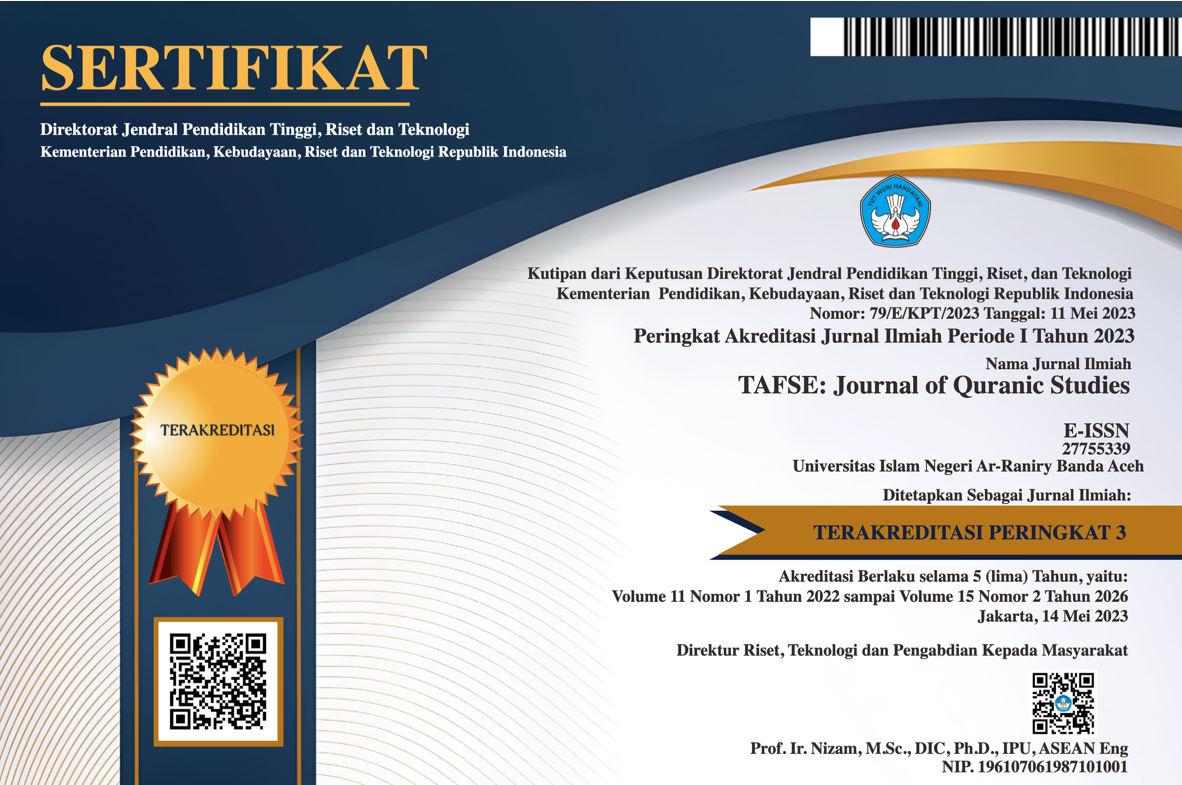Kedurhakaan Istri Para Nabi dalam Alquran
DOI:
https://doi.org/10.22373/tafse.v7i1.12418Keywords:
Kedurhakaan, Istri, AlquranAbstract
The Qur'an states that a good person will be paired with the good and the bad will be united with the bad. However, in reality, not everyone who behaves well is juxtaposed with the good, and vice versa. As the story in the Qur'an is about the lives of two prophets namely Prophet Noah and Prophet Luth who were so obedient to Allah but they were juxtaposed by Allah with a couple who had bad qualities and disobedient. The purpose of this study is to discuss the forms and factors triggering the iniquity of the wives of the prophets and reveal the moral lessons contained in the story. This research uses a qualitative approach with the type of literature research and collects data using interpretation document studies. The results showed that the form of iniquity committed by the wives of Prophet Noah and Prophet Luth was a matter of faith, not that which showed adultery. The cause of the disobedience of the wives of the two prophets is based on two things, namely first, the strength of faith in their former beliefs; the second is because of the economic instability that befell the two families of the prophet so that his spouse committed deceit and betrayed them. The wisdom that can be learned from the story of the disobedience of the wives of the prophets is to show the guarantee of the salvation of the life of the world and the hereafter not to depend on others but oneself.
Al-Qur’an menyatakan bahwa seorang yang baik akan dipasangkan dengan yang baik dan yang berperangai buruk akan disatukan pula dengan yang buruk. Namun, pada realitanya tidak semua orang yang berperilaku baik disandingkan dengan yang baik, begitu pula sebaliknya. Sebagaimana kisah dalam Alquran tentang kehidupan dua orang nabi yakni Nabi Nuh dan Nabi Luth yang begitu taat kepada Allah tapi mereka disandingkan oleh Allah dengan pasangan yang memiliki sifat yang buruk lagi durhaka. Tujuan penelitian ini untuk membahas bentuk dan faktor pemicu kedurhakaan istri para nabi dan mengungkapkan pelajaran moral yang terkandung dalam kisah tersebut. Penelitian ini menggunakan pendekatan kualitatif dengan jenis penelitian kepustakaan dan mengumpulkan data menggunakan studi dokumen tafsir. Hasil penelitian menunjukkan bahwa bentuk kedurhakaan yang dilakukan istri Nabi Nuh dan Nabi Luth adalah dalam persoalan keimanan bukan yang menunjukkan perbuatan zina. Penyebab durhakanya istri dari kedua nabi tersebut didasari kepada dua hal yakni pertama, kuatnya keimanan terhadap kepercayaan mereka yang terdahulu; kedua yaitu karena ketidakstabilan ekonomi yang menimpa kedua keluarga nabi tersebut sehingga pasangannya berlaku curang dan khianat kepada mereka. Adapun hikmah yang dapat dipetik dari kisah durhakanya istri para nabi tersebut yaitu menunjukkan jaminan keselamatan kehidupan dunia dan akhirat tidak bergantung kepada orang lain melainkan diri sendiri.
Downloads
References
Abu al-Fida Ismail bin Katsir. Kisah Para Nabi, Terj. M. Abdul Ghoffar. Jakarta: Pustaka Azzam, 2005.
———. Tafsir Ibnu Katsir, Terj. Arif Rahman Hakim, Dkk. Surakarta: Insan Kami, 2015.
Ahmad Khalil Jam’ah & Syaikh Muhammad bin Yusuf Ad-Dimasyqi. Istri-Istri Para Nabi., n.d.
Al-Qurthubi, Imam. Tafsir Al-Qurthubi, Terj. Dudi Rosyadi, Dkk. Jakarta: Pustaka Azzam, 2009.
Ali Muhammad Ash-Shallabi, Nuh Alaihissalam. Peradaban Manusia Kedua, Terj. Masturi Irham & Khoeruddin Basarah. Jakarta: Pustaka al-Kautsar, 2020.
Departemen Agama RI. Alquran Dan Terjemahnya. Jakarta: Karya Insan Indonesia, 2004.
Katsir, Abu al-Fida Ismail bin. Kisah Para Nabi: Sejarah Lengkap Perjalanan Hidup Para Nabi, Sejak Adam As Hingga Isa As, Terj. Saefulloh MS. Jakarta: Qisthi Press, 2015.
M. Quraish Shihab. Tafsir Al-Misbah: Pesan, Kesan Dan Keserasian Alquran, Vol. 14. Jakarta: Lentera Hati, 2002.
M. Quraish Shihab dan Najwa Shihab. Shihab & Shihab: Bincang-Bincang Seputar Tema Populer Terkait Ajaran Islam. Tangerang: Lentera Hati, 2019.
Muhammad Ainun Najib, Dzulkifli Hadi Imawan. “Dinamika Intelektual Dan Peradaban Islam Pada Masa Rasulullah.” Jurnal Pemikiran Islam 2, no. 1 (2022): 105.
Murad, Mushthafa. 70 Kisah Teladan Berdasarkan Alquran Dan Hadis-Hadis Pilihan, Terj. Ija Suntana, n.d.
Qadrunnada, Khalisoh. “Pasangan Ideal Menurut Alquran (Kajian QS. Al-Nur Ayat 26 Dan QS. Al-Tahrim Ayat 10-11).” UIN Syarif Hidayatullah Jakarta, 2019.
QS. Al-Tahrim (66): 11. (n.d.).
Quthb, Muhammad. Figur Wanita Sorga Dan Neraka, Terj. Zein Husein Al-Hamid. Surabaya: Amarpress, 1987.
Santi Maritno Hasibuan. “Kisah Kaum Nabi Luth Dalam Alquran Dan Relevansinya Terhadap Perilaku Penyimpangan Seksual.” Yurisprudentia: Jurnal Hukum Ekonomi, 5, no. 2 (2019): 203.
Sayyid Quṭb. Tafsīr Fī Ẓilal Al-Quran, Terj. As’ad Yassin. Jakarta: Gema Insani, 2004.
Siregar, Dina Rahmatika. “Kisah Istri Nabi Luth Dalam Alquran (Pesan-Pesan Moral Dibalik Ketidaktaatan Istri Nabi Luth.” UIN Sunan Kalijaga Yogyakarta, 2016.
Sofyan Hadi. Tafsir Qashashi: Umat Terdahulu, Tokoh, Wanita, Istri Dan Putri Muhammad Saw. Serang: A-Empat, 2021.
Suhufi, S.M. Kisah-Kisah Dalam Alquran. Bandung: al-Bayan, 1995.
Umar, Subehan Khalik. “Hak-Hak Kaum Minoritas Dalam Hukum Islam.” Al Daulah : Jurnal Hukum Pidana Dan Ketatanegaraan 5, no. 2 (2016): 412–26. https://doi.org/10.24252/ad.v5i2.4858.
Downloads
Published
Issue
Section
License
Authors who publish with this journal agree to the following terms:
- Authors retain copyright and grant the journal right of first publication with the work simultaneously licensed under a Creative Commons Attribution License (CC BY NC 4.0) that allows others to share the work with an acknowledgment of the work's authorship and initial publication in this journal.
- Authors are able to enter into separate, additional contractual arrangements for the non-exclusive distribution of the journal's published version of the work (e.g., post it to an institutional repository or publish it in a book), with an acknowledgment of its initial publication in this journal.
- Authors are permitted and encouraged to post their work online (e.g., in institutional repositories or on their website) prior to and during the submission process, as it can lead to productive exchanges, as well as earlier and greater citation of published work (See The Effect of Open Access).





